Related Content
Content
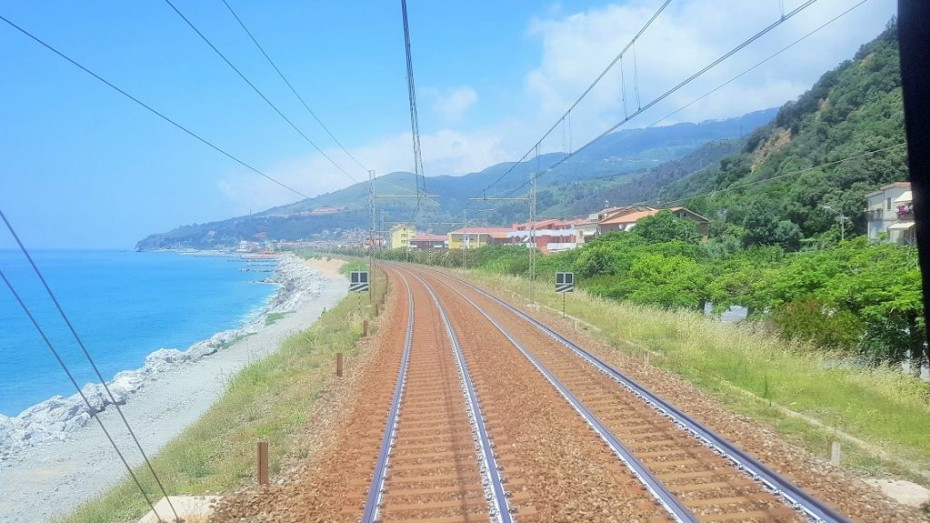
How to travel by train in Europe
Want to take a new European train journey and not sure how? This beginner's guide can help make it happen.
Share
One of the things which inspired the creation of ShowMeTheJourney is the gap between those who say they want to go by train and those that actually go ahead and make a journey.
So this guide will help remove concerns about how to get from A to B by train in the 16 European countries which have the highest number of rail travellers.
It's packed with links to fairly detailed explanations of those aspects of train travel which can be confusing, such as how to buy train tickets, find trains at stations and discovering if a train can take you where you want to go.
But this beginner's guide to European train travel will also show you how to make the most of the journey, by using the on-board facilities and seeing the best of the scenery.
The core idea is to show you that taking a new European train journey can be much easier than you think it would be.
Though the many quirks around European train travel have had to be included too and explaining them can require a weight of text, but that knowledge is key to understanding the wonders of European travel.
Smarter and faster trains, easier to use stations, more direct routes and simpler online ticket booking, all contribute to this Golden Age of European Rail Travel, so now you can discover it for yourself.
How easy will your journey be
If you're considering a rail journey the first thing you need to know is whether you can get there by train.
Because the goal of train travel providers is to make money, direct trains are typically available if you'll be trying to travel from one city to another that's less than 150km / 100 miles in distance; and many trains inevitably cover much longer-distances.
Europe's main railway routes have always been planned so that the dominant cities in a country can be connected as quickly as possible, but this also means that capital cities can be similar to spokes in a wheel, from which railway lines fan out across a nation.
This is the case when travelling to and from London, Paris, Madrid, Prague, Budapest and Stockholm, meaning that rail journeys across country are less frequent but they are possible.
In other countries, cities other than the capital have become the hubs of railway networks, including Frankfurt in Germany; Milan and Bologna in Italy; and Zurich in Switzerland.
To where it is beautiful
Many railways across Europe have also been built with tourists front of mind, or have survived because of the access they provide to dramatic landscapes.
Hence it's possible to take trains to, from and within beautiful locations such as the Swiss Alps, the Scottish Highlands, The Black Forest, Wales and pretty much anywhere on the Mediterranean Sea's northern coastline.
You can look for journey guides to taking more than 1000 of most popular rail routes using the search box below.
The guides show whether a journey is direct, requires connections, how frequent the trains depart, how long the journey will take and what to look out for when booking tickets.
They feature easy access to useful info on the stations and trains, plus links to the multiple agents which sell tickets for the journey online; and on the scenic routes there are tips for making the most of the journey.
Making connections
Taking direct trains isn't always an option due to geography or quirks of railway history, but this doesn't have be a barrier to making a rail journey.
The railway networks of Austria, Switzerland and The Netherlands function like giant metro systems, with simple as can be connections between trains.
What can be a tad trickier are the longer journeys by express trains, which can require seemingly random connections.
When buying tickets for such journeys, the ticket agents tend to assume that you'll want to reach a final destination in the fastest possible time, but that can involve making connections against the clock; and yes this is best avoided.
A minimum of 30mins is optimal
One of my golden rules is to always allow more than 30 minutes to make a connection between trains, because it typically makes an end-to-end journey less stressful.
More often than not ticket agents don't sell tickets for journeys which involve a risk to a traveller losing out financially, in the event of missed connections, due to delays to a preceding train.
Though having to visit a travel desk mid-journey to rearrange tickets and reservations on subsequent trains is a scenario best avoided.
So three tips to avoid it:
- On the advance search options on many booking services its possible to set a minimum connecting time between trains, so set it to at least 30 minutes.
- If you're given a choice of end-to-end journey options with connections, don't choose the final option of the day, set off earlier and give yourself more contingency time in the event of delays.
- Book separate tickets for each part of a journey and give yourself three hours or more to see something of the city, where you will be making a connection, between trains. Drop your bags in the left-luggage and set off exploring, or have a long lunch in a restaurant in or near the station.
How to travel
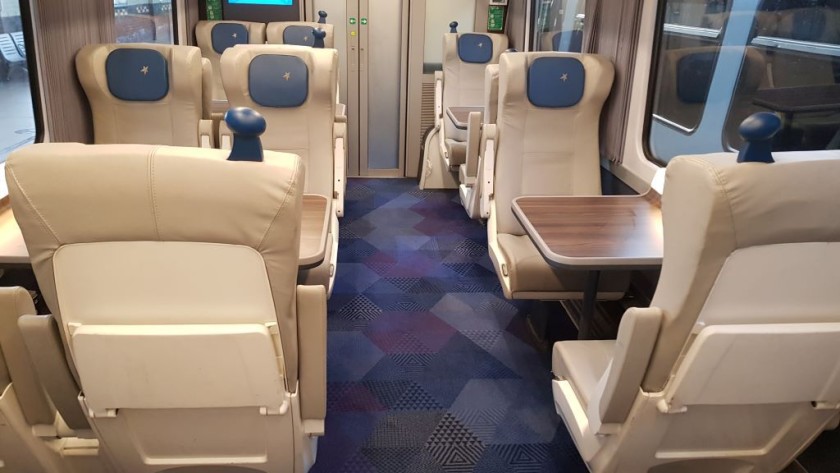
Having established that a train can take you to your destination, you can decide how you are going to make the journey, because on most European trains first and second class will be available.
On express trains in first class ,the seats are always larger and the space between them is greater in comparison to second class, so the core idea is that the journey will be more comfortable, the more you pay for your ticket.
Though whether you choose first or second makes little difference to the ticket booking.
Typically the different types of ticket will be available for travel in first or second; And how the tickets can be used is dictated by the type of ticket and not which class you have chosen to travel by.
If you won't be travelling long-distance, so will be taking a regional train, the difference between second and first class can seem marginal, but what you are partially paying for by booking first class tickets, is a higher possibility of finding available seats when travelling on trains on which reservations are not available, or are optional.
First Class benefits
Travelling in first class is also the only means of accessing these travel benefits; when they are available on a route:
- Travelling in single seat with no other traveller beside you; the seats in the first class areas on most European express trains are arranged 1 + 2 across the aisle.
- Access to passenger lounges at stations; though in some countries including France, these are now only accessible to bookers of the equivalent of Business Class tickets.
- Not having to leave your seat in order to obtain hot food.
The first class travel experience can vary significantly depending on the specific train service that you will be travelling by
A key difference in what's available in first class can involve the catering service.
It ranges from a complimentary meal, similar to what would be served in a restaurant car on the train, to no at-seat service at all.
Less obvious benefits of travelling first class can include:
- More space in which to store luggage
- Access to enhanced Wi-Fi
- More power sockets, including USB sockets
- An increase likelihood of being sat at a table.
A quick guide to train tickets
There are two core paths to take to obtaining tickets for your rail journey:
(1) booking walk-up tickets at the station just before boarding;
(2) booking online before you head to the station.
Travellers can be wary of booking at stations because the ticket counter staff may not speak English, but two tips around this are:
- give the ticket machines a try, those you'll find at major stations generally have excellent multi-lingual translations.
- look up a journey, using the tips below, and take the info, the departure times and train number to the ticket desk; don't worry about what a train number is, that's explained further down the page.
The core reason for making the effort to book online is to save money, because if you want to take an express train service, no matter the distance, it's more than likely that discounted tickets will be placed on sale; and the further ahead you book, the cheaper they will be.
Train journeys in Belgium and The Netherlands are exceptions.
You can also book these discounted tickets at the Advance travel desks at major stations, but to make the biggest savings you typically have to book weeks ahead.
In contrast tickets for local and regional trains are hardly ever discounted, so usually you won't lose out if you book them just before hopping on board.
Direct regional trains can travel long-distances such as Roma ↔ Firenze/Florence; Lyon ↔ Marseille and Munche/Munich ↔ Salzburg.
if you will be buying walk up tickets at the station, regional services such as these, are often cheaper than travelling by the express trains.
Checking train times
So the suggestion above was to buy tickets for journeys by local and regional trains at the station, so this nugget of advice will seem a tad bizarre.
Because before heading to the station it's a good idea to check the times of the departures to your destination, more often than not, this is most easily done by looking up a journey on a ticket booking service.
Many of them now have a check train-times functionality.
Most European countries offer train journey planning and timetables apps and online services; you'll find links to them on the country guides.
Online 'departure boards' are also available for most main stations and if a station has one, you'll find a link to it on the station guides.
A frequent longer-distance express or regional rail service in Europe would comprise a train every hour, and a frequent local service would be a train every 30-60 minutes.
This level of frequency is typical across Belgium, Switzerland and The Netherlands, and is also found away from the rural areas of Austria, Denmark, Germany, Great Britain, Hungary and Italy.
Though countries in which the timetables are less regular include France, Norway, Poland, Spain and Sweden.
Why it matters in which country you'll be travelling
One of the odder aspects of European train travel is the variations between how rail journeys can be taken in each country.
All European countries either have a dominant government funded national rail operator, or a state managed organisation which oversees its railways, and they set the 'rules' around travel.
So each country has it own policy around multiple aspects of travelling by train, which include, but are not limited to:
- How far in advance tickets are placed on sale.
- The T&Cs around the refund and exchange of train tickets.
- The seat reservation policy on express trains.
- What extras you will and won't receive on board if you book First Class tickets
- The T&Cs for child tickets.
- How seniors can and can't obtain discounted tickets.
- How to travel on trains with a non-folding bicycle.
- How to travel on trains with a dog.
- The T&Cs for using rail passes such as Eurail and InterRail.
- Whether railcards which save money on tickets will be available.
Of course if you're only making some journeys by train in Italy you won't need to know the 'rules' around taking bikes on trains in France. However, if you're a regular traveller by train in your home European country, it's easy to assume that what you know about buying train tickets etc will also apply in another country, but it won't.
Hence the guides to travelling by trains in these 16 countries on the buttons below, will be worth the 10 mins of your time that it will take to read them; and more of them will be added soon.
Know your stations
This may be No.1 on the most potentially confusing aspects of European train travel, as many major cities have more than one station used by long-distance trains.
This matters both when booking tickets; travelling to one station can be cheaper than another; and when you're on the train you need to know where to leave it.
Hence the journey guides show how to take trains from and to the main stations in each city and they also point out the alternative station options.
It can be a good idea to check the locations of the start and finish points of your end-to-end journey on Google Maps and seeing either, which are the nearest main stations, or which have the easiest public transport connections.
Larger cities including Budapest, Paris, London and Madrid have no main central station, but instead have multiple stations on the edge of their central area, serving trains which head off in different directions.
In other cities including Basel, Brussels, Genoa, Glasgow, Hamburg, Lille, Lyon, Manchester, Prague, Turin and Vienna trains can depart from one station, but not another.
Many trains also call at more than one 'central' station in these cities; Glasgow and Lille excepted.
Identifying the main station in a city
The use of word resembling 'Central' in a station name means that the station will indeed be the main city centre station, but not all stations follow this pattern.
In Austria and Germany the main city centre stations are known as hauptbahnhofs, which is often shortened to 'hbf'; in Czechia 'hln' is used and in Poland the main stations are 'glowny'.
Other main city stations can be named after a local landmark, a local area, or named in honor of an individual, hence these being some of the less obvious names of main city centre stations:
- Barcelona Sants
- Birmingham New Street
- Edinburgh Waverley
- Firenze Santa Maria Novella (Florence)
- Marseille St Charles
- Roma Termini (Rome)
- Venezia Santa Lucia (Venice)
- Verona Porta Nuova
The language of train travel

Taking a new train journey requires the taking on of information, buying the appropriate ticket, finding the train at a station and working out when to leave it etc.
Therefore many would be travellers have concerns that they will be able to understand this info in a foreign land.
However, most of the info that rail traveller's need is presented visually on the departure screens at stations and increasingly on displays within the train.
Also many announcements at stations and on board trains are in both the native language and English, though France is an exception to this.
But train travel itself has a unique vocabulary and it inevitably gets used all over ShowMeTheJourney, including this guide.
So if you're confused by what is meant by reservations, train numbers, rail passes etc, check out the guide below.
Finding your train:
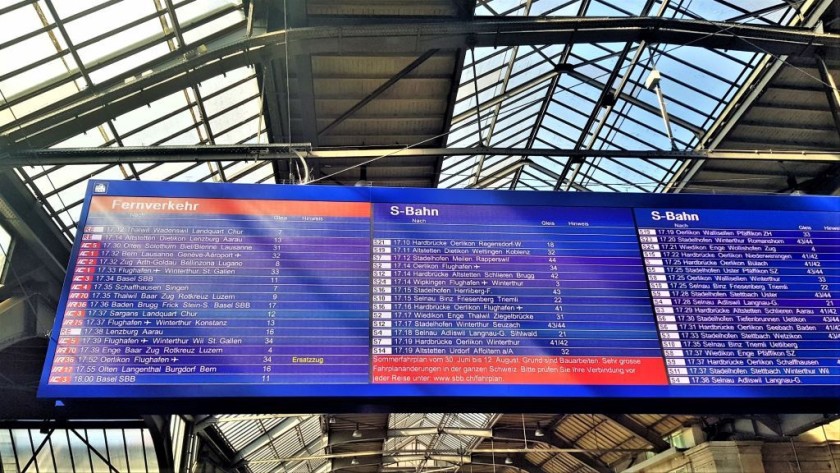
The major stations of Europe can be awe-inspiring, but they can also be tricky to navigate, partially because they weren't designed with once in a lifetime travellers front of mind, hence many of them feature multiple entrances and short-cuts, to make life easy for their daily users.
Some of them also have multiple parts, used by different train services, and some of these different areas of a station can be some distance from the main entrance.
Other stations are akin to layers of cake, with some of the trains leaving from parts of the station above ground, with others using subterranean parts of the station, even though they are not metros.
These multi-dimensional stations, of both types described above, include: Antwerpen Centraal, Berlin Hbf, Bern, Bologna Centrale, Bruxelles-Midi; London St Pancras International, Madrid Atocha, Manchester Piccadilly, Munchen Hbf, Paris Gare De Lyon, Paris Montparnasse, Roma Termini, Wien Hbf and Zurich HB.
So if you already have a ticket it can be a good idea to be at a major station for the first time a minimum of 15 mins before your train departs
If you will joining a train at city station where it's commencing a journey and don't have a reservation, add on another 15mins, so that you can be among the first to board when your train's departure details are confirmed.
If you'll be buying a ticket at station allow 30 mins to make a purchase to allow for queues at both ticket counters and ticket machines.
Add on another 20 mins to all of the above timings, if you'll want to buy a coffee etc before heading to the train, this last minute food/drink purchasing can be more complicated that you might assume.
If you will be taking a Eurostar, or a high-speed train in Spain or a Thalys train service, also factor in the check-in times / security procedures.
Making use of the departure boards
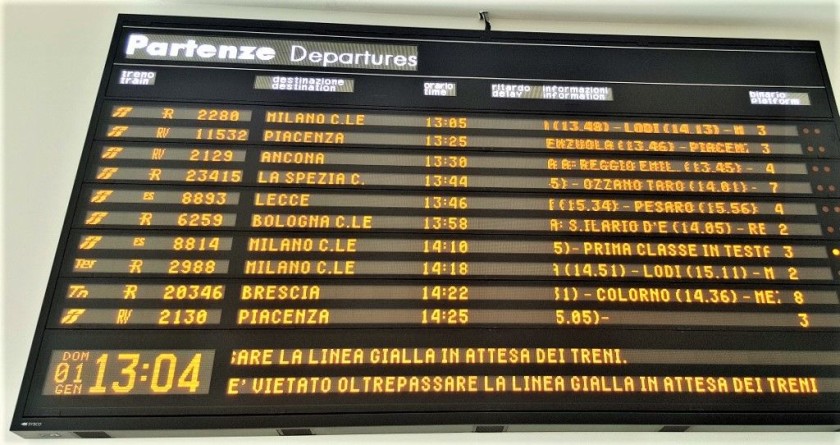
You will be likely relying on the visual info at the station to find the train you'll be taking, because these days the details of departures are rarely announced.
So you'll need to use two types of visual info, one of which will tell you the platform/track etc you will need to head to; and the other will tell you how to make your way to it.
Most of Europe's large multi-level stations have elevators which give access to the trains if you have heavy luggage etc, but they can be out of sight, away from the most obvious routes to the departures.
So if you'll want to use them don't assume that they don't exist because you can't see them, look out for them on the station signage, or ask station staff.
Precisely how you find out which platform/track you need head to varies between counties, hence the guides to using stations below, plus the info you'll find on the country guides
What to particularly look out for
The three key pieces of info, which will help identify the train you need to take, are:
1: It's departure time - if you will taking a local train so the time won't be on the ticket, ask at the ticket counter what time it will be leaving.
2: The final destination of the train - it will be either written in the language at the destination, or the local language of where you are; so look that info up before you head to the station, it can be super useful to know that Anvers = Antwerp; Firenze = Florence; Wien = Vienna etc.
This can matter because most of the main departure boards at European stations won't show every station that the trains will be calling at; though Great Britain is an exception to this.
It's why the final destination of the train is always included on the journey guides.
3: The train number - In Austria, France, Czechia, Germany, Italy, Poland, Spain and Sweden, the easiest method of finding your train on the departure board, is to match the train number on your ticket, to the corresponding numbers on the departure screens.
On this Italian departure board pictured above, Train no. 2280 is leaving from platform 3 and Train no. 2129 is leaving from platform 4.
Train numbers for international trains can also be shown in countries where numbers aren't used for the domestic services.
Working out which platform / track you need to head to
The key piece of information you'll need to know is which specific platform / track your train will be leaving from.
Many European departure boards have multi-lingual headers, which will show where to look for these platform/track details.
Also don't be surprised if when you first look at a board you see a blank space where the info should be, because it will suddenly appear as soon as it is confirmed.
Even without a translation it's normally fairly easy to work out where to look, because its the column with the least info in it.
Though at stations, systems of letters can be used for each platform/track instead of numbers.
Plus at most Dutch stations and some British stations, including Birmingham New St, Edinburgh Waverley and Leeds, you will see both a number and a letter; because the platforms are split into different sections indicated by the letters, and trains can depart from these specific sections.
Also in eastern Europe including in Poland and Croatia you may see two numbers, one of which is for the platform and the other is for the track, because the platform can be split into the equivalent of the quarters.
There's no getting away from how confusing all of the above can be, but most major European stations have information desks at which you can check everything you need to know about how to find your train.
The info screens on the platform / track
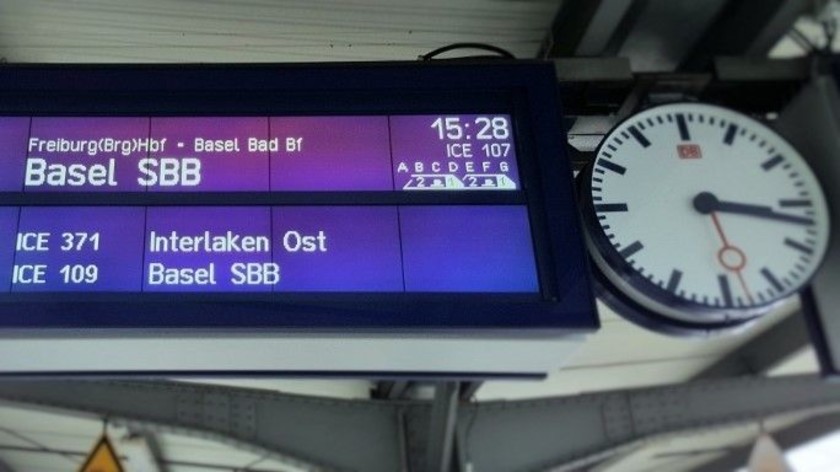
If you will be joining a train at an intermediate station, there will be other departure screens on the platform which show the details of the next train to be leaving from it.
So you can confirm you're at the right place, but look twice because your train may not be the next to leave.
These screens can also show info that wasn't on the main departure board, including all of the calling points and where to wait for easy boarding into 1st class, the on-board restaurant, or the bike spaces.
If you will be changing trains look out for any departure summary screens, when you step off the train.
Using departure posters
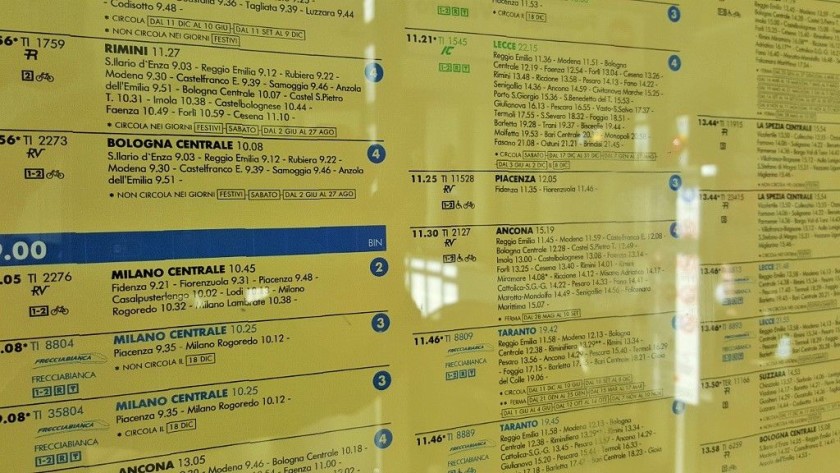
Though once you have ticket there is often an ol-skool method of working out where your train will/should be leaving from.
At stations in Austria, Belgium, Germany, Italy, Poland, Spain and Switzerland, there will be departure posters listing every train and they have the platform/track numbers on them.
Though if the info on the screens is different, follow that instead.
International trains across borders
One of the most exciting aspects of travelling on European trains is the possibility of being whizzed across a border, but how to do this can range from simple as can be, to somewhat bizarre.
Though a perception can be that it's more tricky than it actually is.
Most of Europe's international daytime journeys by train are little different to travelling within a country, the trains seamlessly cross the border without any fanfare, you'll only know that you've arrived in a different country when your mobile phone let's you know it's changed network provider.
This is the scenario on any journey by international high speed trains, though on Eurostar the Channel Tunnel also gives the game away that you're arrived in another country.
However, only a tiny percentage of European trains make international journeys and on many routes only one train per day is available.
And some direct international journeys are only possible on night trains; these include:
- Amsterdam ↔ Munich & Zurich;
- Vienna ↔ Amsterdam, Brussels, Bucharest, Paris & Rome;
- Zurich ↔ Amsterdam, Prague and Zagreb;
- Rome ↔ Munich and Vienna.
So these international journeys can get lost in the online journey planners and timetables, so it's easy to make an assumption that a direct train won't be available, when in fact it will be.
Hence the journey guides, which can be looked up below, nearly always include every direct international rail route from each city.
A note on international rail tickets
Booking tickets for an international European journey by train is little different to taking a national trip, though as the journey guides point out, it's usually a good idea to compare prices on the national ticket providers of the countries in which the journey will be beginning and ending.
Though because all of the national rail companies inevitably focus their attention on their domestic routes, particularly lengthy international journeys tend to be susceptible to the need to make random connections between trains; and this can cause complications with the ticketing.
More info on how to successfully manage this scenario is in the 'Making connections' section above
Look for a journey guide
DIFFERENCES WITH FLYING:
Making a journey by train is a very different end-to-end experience compared to taking a flight, which can make those used to the rituals of taking a plane nervous, but taking a train is nothing to be afraid of and it's also infinitely more pleasurable.
There are also numerous opportunities for your first experience of European rail travel being the train journey from an airport.
You can take a long-distance train instead on to a a final destination having to take another flight, when arriving in Europe at these airports; Amsterdam, Copenhagen, Frankfurt, Manchester, Paris-CDG and Vienna.
Seat reservations
A big difference between taking a plane and a train is that a train ticket doesn't always guarantee a seat, but more often than not when travelling long-distance this isn't something to be concerned about.
Included reservations - because they are mandatory
On many trains, including all of Europe's high-speed train services, seat reservations are mandatory - except when travelling on ICE trains to/from Germany, outside the peak summer period.
In effect what this means is that you when you buy a ticket you will have an automatically assigned seat(s) - though when it's an additional option, it can be a good idea to choose your seat(s) on a seating plan.
The seat number will be on your ticket, just as it is on an airline ticket / boarding pass.
This mandatory seat reservation also applies to most other international trains and on the other express trains in France, Hungary, Italy, Poland and Spain.
Opting to add a reservation
When seat reservations aren't mandatory they are usually optional; though they aren't available on any national train in Belgium and The Netherlands.
In Austria, Czechia, Switzerland and now when travelling both 1st and 2nd class in Germany, you can pay a small fee to add them to a booking.
When booking certain types of ticket, including Advance tickets in Great Britain and the most expensive types of ticket for travel by German ICE and IC trains, assigned seats are included in the booking.
Though there are numerous exceptions to this, so the seat reservation guide below can be worth five minutes of your time if you want to be sure of having an assigned seat on the train.
Also keep in mind that in summer and around national holidays in particular, seats can sell out on certain departures, so it can pay off to be booking and arranging seat reservations at least a couple of weeks ahead.
**A note for travellers from North America
When taking a long-distance daytime rail journey in the USA and Canada, when you make a booking the most common terminology is that you have booked 'a reservation' - Because you will be travelling on a specific departure and the number of tickets available to travel by it, won't exceed the number of seats on the train.
So you may be used to a system on which you have reserved a place on the train, but unless you also use a 'seat selection' service, when it's available, you won't have a specific seat(s) / place on the train assigned to you.
Hence many clients from North America who use the Concierge Service understandably assume that European trains can't be boarded without a reservation.
However, in Europe;
- a ticket is the equivalent of what in North America is termed a reservation,
- a reservation is what is commonly referred to in North America as seat selection.
Boarding
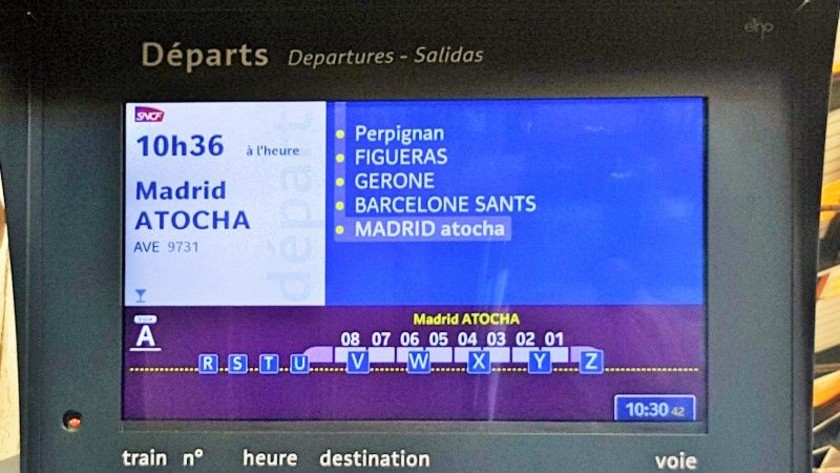
If you take *the Eurostar or a high-speed train in Spain, in the station prior to accessing the train, you will experience a similar process to airline departures, luggage will be screened, tickets will be scanned or manually checked etc, but when taking any other European train, you simply walk on to the platform / track and then step on board.
In Britain and The Netherlands you typically have to pass through a gate, which can now be opened by reading a ticketing barcode on a mobile phone, but in other countries you can board without showing a ticket.
This scenario also applies more often than not when taking international European rail journeys, your passport etc may be inspected on the train at some point during the journey.
Making your way to a reserved seat
Another key difference with flying is that if you have a reserved seat. it will be in a designated coach / carriage on the train, but European trains have up to 20 coaches.
Running along a platform when a train arrives in a station, or having to make your way through a train after you have boarded, are two scenarios that are more awkward than boarding at an airport gate.
However at major stations in Austria, France, Germany, Italy and Spain, information will be available at the station, which you can use to work out where to wait for your train, so that you will be by the coach in which your seat(s) are located, when the train arrives in the station.
Either the platforms/tracks at the stations are split into zones and the departure screens show which coaches will be in each zone, as on the image above, or signs along the platform will show which coaches will be beside them.
This info is also becoming increasingly available in Great Britain and when boarding international trains in other countries.
The on board info
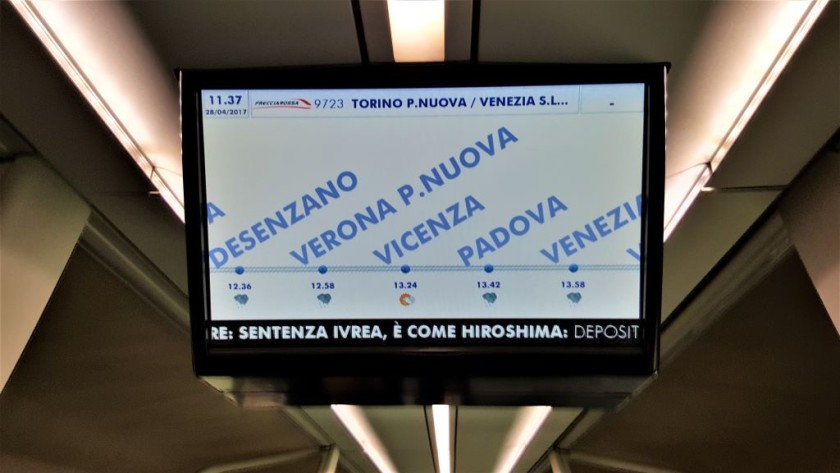
There are two key items of visual information that are available on trains, particularly if you will be making a long-distance journey.
-
If you have reserved a seat you need to find it, or if you haven't reserved when it's not mandatory you'll want to work out which seats are available for you to occupy.
When reservations are mandatory or available the seats on the train will be numbered.
Though on journeys on which reservations are optional, there will be a display system which will show the stations between which the seats have been reserved; and in this scenario no info indicates an available seat. -
Most European express trains now have screens within the coaches, which can be used to work out the next station call and the time of the trains arrival at that station.
This next station info is also typically announced by the on board conductor; and in most countries the info will also be given in English.
Though trains can call at more than one station in city, so listen and watch out for the exact station that you will be heading to.
Night trains
Overnight trains can be an alternative to daytime trains, or they can be the only direct rail services between two distant cities.
They can be money and time savers, but travelling by them is a very different experience to taking daytime trains, aside from the obvious of being in a bed or couchette berth, instead of a seat; though spending the night in a seat is an option on most sleeper services.
How to book places in those sleeping cabins and couchettes is inevitably a tad trickier, but not impossible once you know how.
And if you're thinking 'what is a couchette? then you definitely need to spend 10-15min learning about how to travel through the night by using the guide below.
The answers to this and many other questions such as where the night trains go, how to book tickets for them and how you can and can't share sleeping accommodation, all await your discovery.
Managing luggage
Another key difference between taking a train instead of a plane is the need to take all your bags with you on board, instead of waving goodbye to larger items at check-in, hoping that you will be reunited with them some day.
However, having travelled with my luggage on more than 300 rail journeys across Europe, there's so many tips on how to mitigate against this being awkward, that they've been spun off into a separate guide below.
Going backwards
Virtually all European trains have seats which face forward and backwards, the only exceptions being some French and some Spanish trains on which virtually all the seats can be rotated so that they face forwards.
But some (many) people aren't keen on the notion of being whizzed backward across the ground at speeds of more than 200 km/h.
If you're a member of this group there are two steps that can be available to avoid this scenario.
- Some seating plans, that you may have access to when booking online, have arrows on them indicating the direction of travel
- When you board, ask the conductor or your fellow passengers if you can swap to forward facing seats
Though something to keep in mind is that trains can reverse in and out of stations during their journey.
All trains which call at these stations during an end-to-end journey will do this:
- Firenze S.M.Novella (Florence)
- Frankfurt (Main)
- Leipzig Hbf
- Luzern
- Milano Centrale
- Munchen Hbf (Munich)
- Napoli Centrale
- Roma Termini
- Stuttgart hbf
Some trains which call at these stations; Basel SBB, Bern, Birmingham New Street, Koln hbf (Cologne), Reading, Verona Porta Nuova and Zurich HB; also reverse direction.
Rail passes
Maybe there are air passes which let you hop around distant lands such as the Pacific Islands by plane, but they don't exist in Europe, which is why rail passes can be a great idea if you want to take a multi-destination holiday.
InterRail passes for those who reside in Europe and Eurail passes, for everyone else, are available if you want to travel solely in one country, or travel across the continent with a confusingly named 'Global' pass.
Used correctly they save time and money, but that word 'correctly' can be off-putting and working out how to best use rail passes can feel like studying for an exam.
Hence the guide below, which is a gateway to the weight of Eurail and InterRail info which can be found on SMTJ.
Grabbing a coffee and a piece of cake to keep you going on while you read it all, will erm help you have a trip of a lifetime.
But if you want to simplify things further by taking multiple memorable journeys in a smaller area, there are many other types of rail pass available.
The scenery
We're entering into stating the obvious territory here, but for many people including myself, in the top 3 reasons for taking a train over a plane, is the opportunity to ride through a fantastic landscape.
When a journey guide involves a trip through a scenic area, ShowMeTheJourney lives up to its name, as they include the 1000s of images and videos I've captured of the stunning views from train windows.
Look for a journey guide
The catering

Something the journey guides strive to include are the specific types of train which are used on each route, because the train you will be travelling by can have a significant impact to the overall journey experience, irrespective of whether you have booked first or second class tickets.
Aside from how comfortable the seats are, the core difference between the types of daytime train used for long-distance journeys in Europe are the catering services, which will or won't be available on board.
The catering options can differ
This can vary more widely than the service available on airlines, because the food and drink availability on European trains can be:
- a restaurant car in which a full meal can be ordered from catering staff,
- a bar counter from which hot and cold fold can be ordered and then either consumed in the bar or taken back to your seat,
- a bar counter which only serves snacks, sandwiches and other cold items such as salads,
- a catering trolley, which is taken through the train,
- vending machines,
- nothing at all.
If you will be travelling in first class the food service available at your seat can range from access to the full restaurant menu, to no catering service.
This catering availability is dependent on the specific type of train used on a route, for example the TGV InOui trains travelling between Paris and Strasbourg don't have restaurant cars, but the less frequent ICE trains do have them.
In Switzerland a key difference between an IC and and IR service, is that all IC services have restaurant cars, but they're not available on IR services.
The country in which you will be travelling can matter
Though the country in which you will be travelling also makes a difference, for example, hot meals aren't available at all on French trains, or on Italian trains, In contrast all Austrian and most German express trains have a range of catering options available - while in Great Britain and Spain hot meals are only available on certain trains when travelling in first class.
On board catering isn't available at all on Belgian and Dutch national trains.
Shopping
For some of us the point of those mini-malls at major airports, that exist between passport control and the boarding gate, is to provide a distraction in the two hours of hanging around pre-boarding.
So a plus of train travel is that you can be at the station five minutes before your train leaves; though that usually that isn't the best way to go.
Though those malls at airports can of course be ultra convenient locations for picking up all sorts of travel essentials, but many of Europe's major stations are also retail destinations; at some stations the part of a building that the trains use, can be hidden out of sight behind the stores.
And this opportunity to shop can be particularly useful if you're going to be following a long itinerary, I've bought, books, T-shirts, bags, shorts, phone chargers etc at stations.
But another difference between train and plane is you need to make your purchases, before you head to the train and pass through the barriers or ticket checks.
Stations which have high numbers of stores available within them, include: Berlin Hbf, Bern, Birmingham New Street, Krakow-Glowny, Leipzig Hbf, London St Pancras, Madrid-Atochca, Paris Gare Du Nord, Roma Termini, Torino Porta Nuova, Wien Hbf and Zurich Hb.
In the center of things
The fact that you can travel from city center to city center is a contender for the reason most often given for choosing train over plane.
This is undeniable, but it's also fair to say that many main central stations are much closer to the central locations than an airport, but are still some distance from the hubs of the cities they serve.
If you take a long distance train to the likes of Barcelona, Berlin, Budapest, London, Madrid, Milan, Paris, Rome, and Vienna, then it's likely that you'll be taking a short hop on tram or metro to reach your final destination.
Though you won't always have to do this.
Large stations which are within 10 mins of the city's main attraction, or the heart of a city, so knock an airport out of the park, include: Bern, Birmingham New Street, Edinburgh Waverley, Firenze Santa Maria Novella, Glasgow Central, Geneve, Hamburg Hbf, Koln Hbf, Leeds, Lille Flandres, Luzern, Manchester Victoria and Venezia Santa Lucia.
SAVING MONEY:
Getting from to A to B by train for the cheapest possible price is obviously what many would be travellers most want to know, hence these tips below.
However something less obvious, which can apply on many routes, is that alternative types of direct train service can be available.
In many countries including Czechia, Great Britain, Italy, Norway, Spain and Sweden different companies in effect compete with each other on long-distance routes, with each company offering their own ticketing services.
On other routes there are slower trains which will often or always be cheaper, particularly when booking walk-up tickets at a station.
Hence the journey guides always strive to include the cheaper alternatives.
Taking slower trains, or making more connections, can also be how users of Eurail and InterRail passes can make savings.
Book ahead
A pretty much universal rule of booking tickets by European express trains is that the earlier you book, the cheaper the discounted types of ticket will be.
The usual advance ticket booking periods are:
- 1 month ahead = Poland
- Up to 2 months ahead = Denmark
- Up to 2 months ahead = Czechia/The Czech Republic
- Up to 2 months ahead = Hungary*
- 12 - 13 weeks ahead = Norway
- Up to 3 months ahead = Great Britain
- 2 - 6 months ahead = Spain the AVE trains to/from Madrid and the TGV trains between France and Spain are now available up to 6 months ahead.
- Up to 4 months ahead = France
- Up to 4 months ahead = the IC day and night trains in Italy
- Up to 6 months ahead = Austria
- Up to 6 months ahead = Germany
- Up to 6 months ahead = the Frecce trains in Italy
- Up to 6 months ahead = Sweden
- Up to 6 months ahead = Switzerland - this is a recent change!
- Up to 6 months ahead = Eurostar on all routes including to and from the UK
Be flexible
If you're going to be taking the train for holiday purposes or for a fun day out, so your travel dates aren't set in stone, keep your journey plans loose.
Most long-distance train tickets, particularly in western Europe are priced according to demand, so if you can avoid the most popular days in a week, or can travel on less busy trains, it's highly likely that you can make big savings.
This isn't a scenario which needs to be kept in mind when booking tickets for journeys within Belgium and The Netherlands, but in the larger countries of western Europe, including Austria, Britain, France, Germany, Italy, Norway, Spain and Sweden, it can pay off to look through the lists of departures.
Or use the tools which many ticket booking services now provide, to help find the cheapest prices on a route, it's possible to save more than €50 by adjusting travel dates and times, by just a few days.
Don't rush it
Because searching through departures over several different travel dates can pay off, don't rush into making a booking.
If you're the type of person who'll spend an evening looking for the best price for a flight to New York, then adopt the same attitude when booking a train journey to Amsterdam, Paris or anywhere.
Or if that sounds like too much hassle, there is an alternative, which could also enable you to make a saving overall.
Be aware of booking fees
At the risk of making a sweeping statement, some of the ticket booking services provided by the national rail operators could be easier to use.
Though to be fair what can make them seem complicated is that they aim to offer their users the maximum choice of ticket types, prices, routes and journeys etc.
So a tip is to make the effort to use advance search options, to remove journeys with connections, or to focus in on the options with a deal attached.
Your patience will be rewarded by paying the cheapest possible overall price, but there are alternative ticket services available, which exist to making the booking of journeys, particularly those with multiple connections, easier.
They can also be a good option, or the only option, if your bank account is held outside of Europe.
Though what these alternative services also have in common is that on the final stage of the booking process, they will add on a booking fee; and those ticket services directly provided by the train operators don't do this.
The pros and cons of discounted tickets
If you can book ahead for a long-distance European journey by train you will typically be able to choose between different types of ticket, and opting for the cheaper type of ticket will obviously be a money saver.
Though there are two things to always keep in mind when making this choice:
- The most heavily discounted tickets are always departure specific, meaning that you have to travel by the train you select when making a booking.
- Because you need to travel by a specific train the T&Cs for the cheaper type of ticket will nearly always state that you won't be refunded if you don't board the train.
It's also likely that, if it's possible to exchange your ticket to another departure, you will then have pay any difference between the price of your original purchase and the price being charged that day to travel on the alternative later train; and this difference can be more than twice what you initially paid.
In response to the pandemic many rail companies, including SNCF in France, have made the conditions around exchanging tickets less stringent, if you arrange an exchange ahead of your travel date.
Though if you miss the train you were booked on to at the last minute, because of circumstances outside the rail companies control, such as a delayed flight arrival, or a public transport issue on route to the station, it's more than likely that you will have to purchase new tickets.
The more expensive type of tickets are nearly always more flexible, their terms and conditions vary across Europe, but if you book them it's likely that:
- you can take any train on your travel date
- they can be exchanged without fees
- you can obtain a refund if you subsequently want to abandon your travel plans.
Please support ShowMeTheJourney
This second version of ShowMeTheJourney is exciting and new, so we are genuinely thrilled that you are here and reading this, but we also need your help.
We’re striving not to let anything get in the way of providing the most useful service possible, hence a facility has been set up with DonorBox which can be used to support the running costs and make improvements.
Instead of advertising or paywalls, your financial support will make a positive difference to delivering an enhanced service, as there’s a lot of ideas which we want to make happen.
So if you have found the info provided here to be useful, please go here to say thank you.
MAKE IT EASIER
Taking a rail train journey in Europe is often straightforward; heading to a station, booking a ticket and then boarding a train can be the optimum way to go.
Or if you're used to booking train travel online in your home country then:
- Searching for a ticket provider on Google etc;
- Then booking tickets online on that service
...is all you have to do.
But if you want to be sure that:
- you'll be travelling with the optimum ticket or pass
- at the price which suits you
- whether a rail pass will save you money
- and want to know what facilities are available on the train...
- ... and at the station
- whether a journey will be scenic
- and if it is, how to make the most of it
Then some pre-planning of your travel by train can pay back every minute you give to it.
Or you can ask ShowMeThe Journey to do that for you.
Take multiple journeys from one or two locations
Travelling to multiple destinations across Europe on an InterRail or Eurail holiday is wonderful, but in SMTJ's experience the only negative is the need to take your luggage on multiple occasions between the station and the overnight accommodation.
For a stress-free holiday based around taking trains to multiple wonderful locations, the easier option is to spend an extended period of time in one location and then head off on multiple day trips.
If you base yourself in a location where multiple journeys will take less than a couple of hours you can book walk-up tickets at the station, so you can be spontaneous and won't lose out financially.
Avoid disruption
Encountering delays can be inevitable when travelling by train, though when taking more than 500 journeys across Europe, I have only been on trains which have arrived more than an hour late on two occasions.
It isn't possible to mitigate against the reasons for those delays, a lightning strike on the power lines and sabotage at a power station; extreme events are required to delay trains for more than an hour, but the most common cause of disruption to the usual service is something that can be checked in advance of travel.
Construction works on or around the railway can cause trains to be diverted on to longer, slower routes or to be replaced by buses for a section of a journey.
Most of this work is undertaken at weekends so if you can be flexible with your travel plans, it can a good idea to check whether work will affect your journey; this info can be found online and links to it are included in the country guides.
Longer term work which impacts on train services over a longer period of time is included on the summary below.
Construction work can also impact on ticketing, they can't be placed on sale until routing has been confirmed and if you can't find the route you want to take on a booking service at all, then this is the most likely reason.

Simon Harper
I wanted to share my passion for train travel and explain how anyone can take the fantastic journeys I have taken.

This is one of more than 100 train travel guides available on ShowMeTheJourney, which will make it easier to take the train journeys you want or need to make. As always, all images were captured on trips taken by ShowMeTheJourney.
This second version of ShowMeTheJourney is exciting and new, so we are genuinely thrilled that you are here and reading this, but we also need your help.
We’re striving not to let anything get in the way of providing the most useful service possible, hence a facility has been set up with DonorBox which can be used to support the running costs and make improvements.
Instead of advertising or paywalls, your financial support will make a positive difference to delivering an enhanced service, as there’s a lot of ideas which we want to make happen.
So if you have found the info provided here to be useful, please consider saying thank you.


















